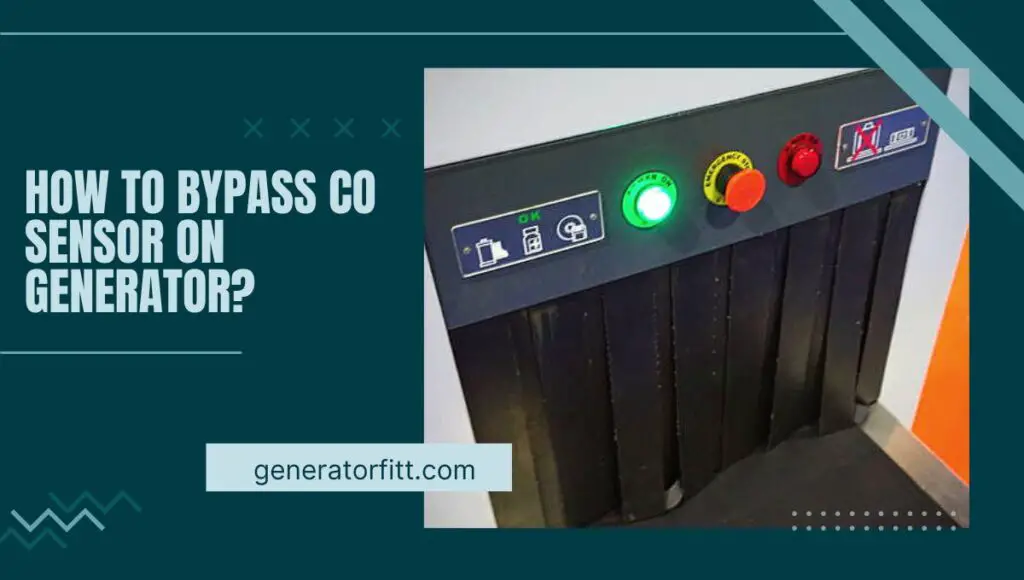How To Bypass CO Sensor on Generator? (Guide) of 2023
How to bypass co sensor on generator? There are a few ways that you can bypass the CO sensor on a generator. One way is to disconnect the sensor from the generator. This can be done by disconnecting the wires that connect the sensor to the generator.
Another way is to bypass the sensor by adding a resistor to the circuit. This will fool the sensor into thinking that there is no CO present.

How To Bypass CO Sensor on Generator?
There are a few ways that you can bypass the CO sensor on a generator. how do bypass co-sensor on the generator? One way is to disconnect the sensor from the generator.
Another way is to bypass the sensor entirely by running a wire from the positive terminal of the generator to the negative terminal of the sensor.
If you need to bypass the CO sensor on your generator, you can do so by following these steps:
- Disconnect the power to the generator.
- Remove the CO sensor from the generator.
- Connect the power to the generator again.
- Start the generator and let it run for a few minutes.
- Shut down the generator and reconnect the CO sensor.
- Start the generator again and let it run until it is up to full power.
A brief overview of carbon monoxide (CO) and the dangers it poses
Carbon monoxide (CO) is a toxic, colorless, and odorless gas that can be produced by any fuel-burning device, including generators, furnaces, gas-powered vehicles, and cooking appliances.
CO is extremely dangerous as it can build up in enclosed spaces, and when inhaled, it can interfere with the body’s ability to transport oxygen, leading to serious health problems or even death.
Some common symptoms of carbon monoxide poisoning include headache, dizziness, nausea, weakness, confusion, and loss of consciousness. These symptoms can vary depending on the concentration of CO and the duration of exposure.
The best way to prevent CO poisoning is to ensure proper ventilation when using fuel-burning devices and to have functioning CO detectors installed in your home or workspace.
Explanation of the importance of CO sensors in generators
CO sensors are critical safety features in generators that are designed to detect the presence of carbon monoxide gas, which can be produced by the generator’s engine.
Since carbon monoxide is a colorless and odorless gas, it’s impossible to detect with our senses, making CO sensors a crucial component in alerting individuals to potential carbon monoxide poisoning.
When a CO sensor detects carbon monoxide gas above a certain threshold, it triggers an alarm to alert individuals to the presence of this dangerous gas.
This alarm gives individuals enough time to evacuate the area and seek fresh air, preventing serious health issues or even death.
Due to the high risk of carbon monoxide poisoning, many local and state regulations require the installation of CO sensors in generators, as well as other fuel-burning devices.
It’s crucial to ensure that your generator’s CO sensor is functioning correctly and has not been bypassed or tampered with in any way.
Safety warning against bypassing CO sensors on generators
Bypassing the CO sensor on a generator is extremely dangerous and should never be attempted. Doing so can lead to a buildup of carbon monoxide gas that can cause serious health issues or even death.
CO sensors are a critical safety feature in generators, designed to detect the presence of carbon monoxide gas and alert individuals to potential danger.
Bypassing the CO sensor eliminates this essential safety feature, and there’s no way to detect if carbon monoxide is present. Even if you believe that your CO sensor is malfunctioning or not working correctly, bypassing it is not a safe solution.
Instead, you should seek the assistance of a qualified professional to diagnose and address the root cause of the problem. Attempting to bypass the CO sensor on a generator is not only dangerous but can also lead to legal consequences.
Many local and state regulations require the installation and proper functioning of CO sensors in generators and other fuel-burning devices, and tampering with or bypassing these sensors can lead to fines or other penalties.
In summary, bypassing the CO sensor on a generator is not a recommended or safe practice and can have severe consequences. Always prioritize safety and ensure that your generator’s CO sensor is functioning correctly and has not been tampered with in any way.
Bypass Co-Sensor on the Generator of all Brand Generators
It is important to note that bypassing the CO (carbon monoxide) sensor on a generator is not recommended and can be extremely dangerous.
The CO sensor is a safety feature designed to detect and protect against the buildup of deadly carbon monoxide gas. By bypassing the CO sensor, you are disabling a crucial safety mechanism, which can lead to potentially life-threatening situations.
Carbon monoxide is a colorless and odorless gas that can be fatal if inhaled in high concentrations. If you suspect that the CO sensor on your generator is malfunctioning or giving false readings, it is strongly advised to contact the manufacturer’s customer support or a certified technician for assistance.
They will be able to diagnose the issue and provide the necessary repairs or replacements to ensure the safe operation of your generator.
Your safety and the safety of others should always be a top priority when dealing with generators or any other equipment that emits potentially harmful gases.
Alternatives to Bypassing CO Sensors
If you suspect that the CO sensor in your generator is malfunctioning or not working correctly, there are several alternatives to bypassing it that you can consider.
These include:
- Checking the placement of the generator: Ensure that the generator is placed in a well-ventilated area and away from doors and windows to prevent CO gas from entering your home or workspace.
- Inspecting the exhaust system: Make sure that the generator’s exhaust system is clear of any debris, and check the muffler for signs of damage or rust that may impact its ability to reduce CO emissions.
- Replacing the CO sensor: If you suspect that the CO sensor is not functioning correctly, you can have it replaced by a qualified professional. This will ensure that the sensor is working correctly and that you’re adequately protected against carbon monoxide poisoning.
- Using a separate CO detector: Consider installing a separate CO detector in your home or workspace to provide an additional layer of protection against carbon monoxide gas. These detectors are designed to sound an alarm when they detect a certain level of CO gas and can alert you to potential dangers.
It’s essential to prioritize safety when operating a generator, and if you suspect that there may be an issue with the CO sensor or exhaust system, seek the assistance of a qualified professional to address the issue.
Explanation of why it’s still not recommended to bypass CO sensors and alternatives to address the root cause of the problem
It’s important to note that bypassing CO sensors is never recommended as it can lead to significant health risks and legal consequences.
CO sensors are designed to detect the presence of carbon monoxide gas, which is colorless, and odorless, and can cause serious health issues or even death. Bypassing the sensor eliminates this crucial safety feature and can lead to a buildup of CO gas, putting individuals at risk.
If you suspect that your CO sensor is malfunctioning or not working correctly, bypassing the sensor is not a safe solution. Instead, you should take steps to address the root cause of the problem.
Some alternatives to bypassing the CO sensor include:
- Cleaning or replacing the air filter: A dirty or clogged air filter can cause the generator’s engine to run inefficiently, leading to increased CO emissions. Cleaning or replacing the air filter can help to reduce emissions and improve the generator’s overall performance.
- Checking the fuel system: A faulty or clogged fuel system can cause the generator’s engine to run inefficiently, leading to increased CO emissions. Ensuring that the fuel system is clean and in good working condition can help reduce emissions and improve the generator’s overall performance.
- Upgrading the exhaust system: Upgrading the generator’s exhaust system with a higher-quality muffler or catalytic converter can help reduce CO emissions and improve the generator’s performance.
- Ensuring proper ventilation: Proper ventilation is essential when using a generator to prevent the buildup of CO gas. Make sure that the generator is placed in a well-ventilated area and away from doors and windows to prevent CO gas from entering your home or workspace.
In summary, bypassing CO sensors is never recommended, and individuals should take steps to address the root cause of the problem.
There are several alternatives to bypassing the sensor, including cleaning or replacing the air filter, checking the fuel system, upgrading the exhaust system, and ensuring proper ventilation.
Prioritizing safety and following these alternatives can help to reduce CO emissions and improve the generator’s overall performance.
People also ask
Can you bypass a carbon monoxide detector?
There are a few ways that you can bypass a carbon monoxide detector, but it is not recommended. One way is to disconnect the power source, but this will usually trigger an alarm.
Another way is to block the sensor, but this can be dangerous because it will not detect carbon monoxide. The best way to avoid carbon monoxide poisoning is to have a working detector in your home.
Do I need a CO sensor on my generator?
If you have a generator, you may be wondering if you need a CO sensor. The answer is that it depends on several factors. First, consider the fuel source for your generator.
If it uses natural gas, propane, or oil, then you likely don’t need a CO sensor. However, if your generator uses gasoline, you may want to consider installing a CO sensor.
This is because gasoline engines produce more CO than other types of engines.
Additionally, if your generator is located in an enclosed space, such as a garage, you may also want to install a CO sensor. This is because CO can build up to harmful levels in enclosed spaces.
How do you not get carbon monoxide from a generator?
To avoid getting carbon monoxide (CO) from a generator, you should follow these safety measures:
Place the generator outdoors: Always place the generator outdoors in a well-ventilated area, away from doors, windows, and vents. This will prevent CO gas from entering your home or workspace.
Keep the generator dry: Always keep the generator dry and protected from rain and moisture.
Maintain proper distance: Keep the generator at least 10 feet away from your home or workspace to prevent CO gas from entering.
Use a CO detector: Use a battery-operated or plug-in CO detector near the sleeping areas of your home or workspace. This will alert you if CO levels become dangerous.
Never use a generator indoors: Never use a generator indoors, including inside your garage, basement, or any enclosed area.
This can lead to a buildup of CO gas and can cause serious health issues or even death. By following these safety measures, you can ensure that you don’t get carbon monoxide from a generator and protect yourself and others from the dangers of CO gas.
Can you get carbon monoxide poisoning if your generator is outside?
Yes, you can still get carbon monoxide (CO) poisoning if your generator is outside, especially if it’s placed in a poorly ventilated area or too close to an open window or door.
CO gas is odorless, and colorless, and can build up quickly, leading to symptoms like headaches, dizziness, nausea, and even death.
That’s why it’s essential to place the generator at least 10 feet away from your home or workspace, in a well-ventilated area.
It’s also a good idea to use a battery-operated or plug-in CO detector near the sleeping areas of your home or workspace to alert you if CO levels become dangerous.
Conclusion
In conclusion, bypassing the carbon monoxide (CO) sensor on your generator is not recommended as it can put you and others at risk of exposure to deadly CO gas.
It’s important to remember that the sensor is there for a reason and eliminating it eliminates a crucial safety feature. Instead of bypassing the sensor, it’s essential to follow the manufacturer’s instructions for the proper use and placement of the generator.
By placing the generator outdoors, maintaining proper distance, and using a CO detector, you can ensure your safety and the safety of those around you.
Remember, prevention is always better than cure, and it’s essential to take the necessary precautions to avoid the risks associated with CO gas.
Hi, I am Brines Loe and I am an Expert in Generators I have Experience in This Field I want to Help You About This Website! Welcome to our generator (Outdoor) Guide blog! We are dedicated to providing you with the latest information and tips on outdoor generators, ensuring that you have the knowledge you need to make informed decisions about which generator is right for you.






